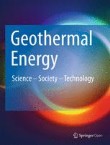Geothermal fluids are usually highly mineralized reflecting the long-term mineral-fluid interactions. This salinity affects not only chemical reactions and impedes chemical analysis and modelling, but the high salinity can cause severe problems due to the formation of mineral scalings and/or corrosion. Understanding these reactions is crucial to guarantee the long-term efficiency and sustainability of geothermal power plants. This special issue is a collection of studies presented at the joint KIT-GFZ-UFZ workshop dealing with field analysis, lab experiments, and geochemical modeling on the salinity effect.
Edited by: Simona Regenspurg and Thorsten Schäfer
